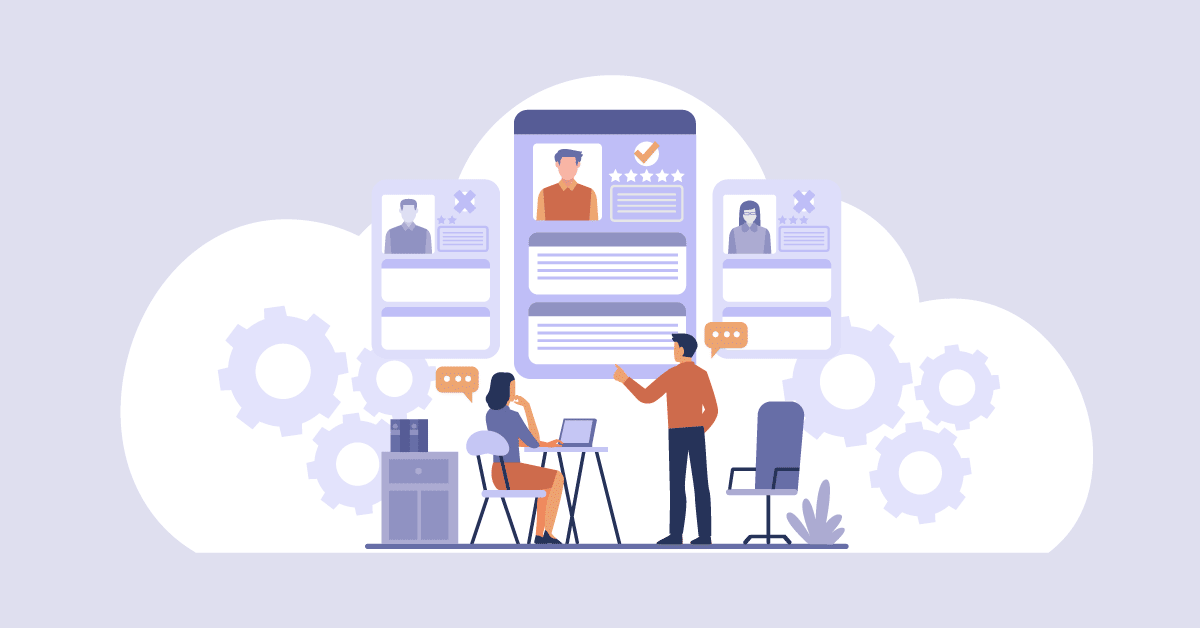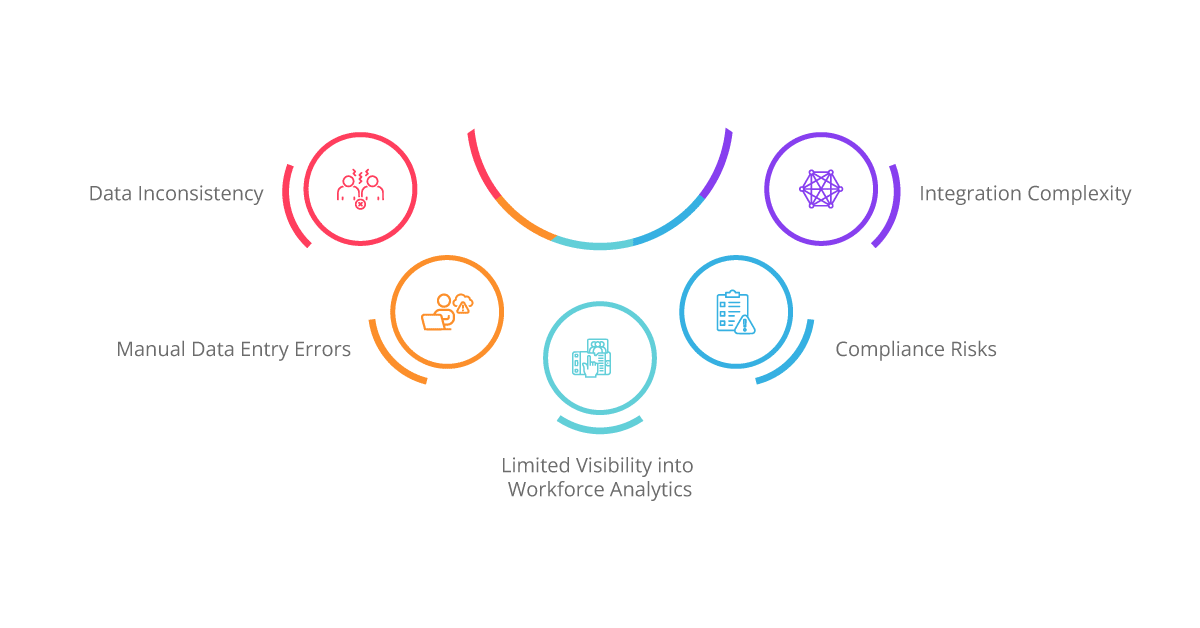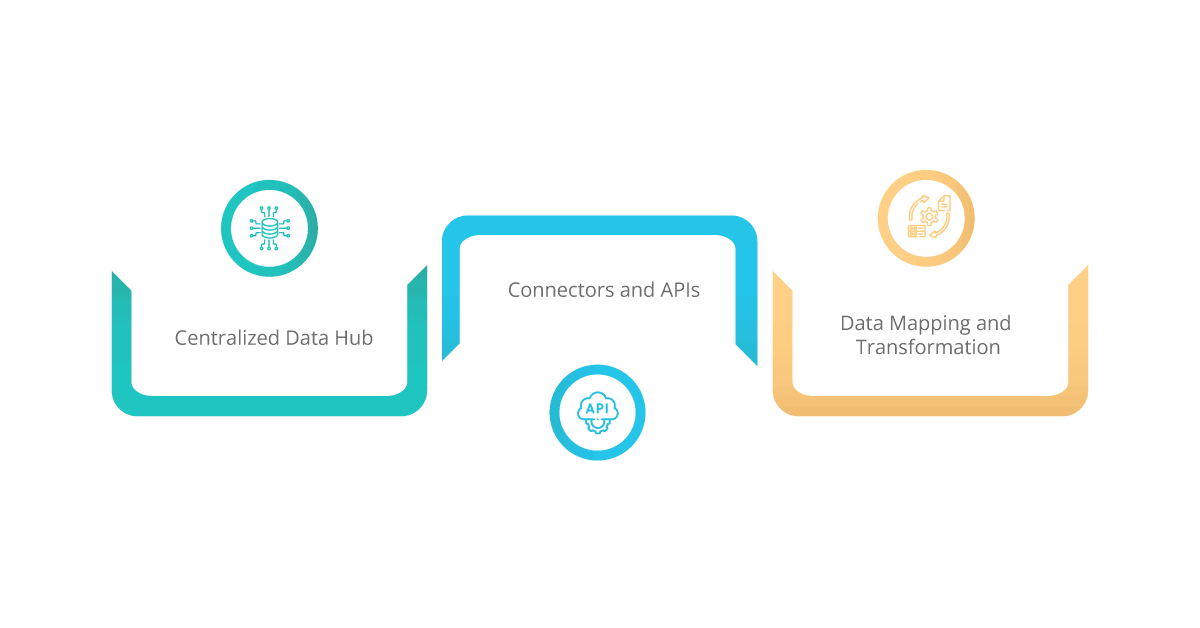The seamless integration of various HR systems has become essential for organizations striving to optimize their workforce management processes. Integration Platform as a Service (iPaaS) emerges as a transformative solution, empowering HR professionals to streamline data integration, enhance connectivity, and drive efficiency across the HR ecosystem. In this blog, we explore how organizations can leverage iPaaS for seamless HR system integration, unlocking the full potential of their HR operations.
Aonflow iPaaS – Free for First 3 Months!
Build and run up to 1,500 transactions monthly with no cost. No payment info needed!
Understanding Traditional Integration in HR
1. Siloed Systems:
Historically, HR departments relied on standalone systems to manage various functions such as payroll, employee benefits, recruitment, and performance management. These siloed systems operated independently, resulting in fragmented data and disjointed processes. For instance, payroll data stored in one system may not seamlessly integrate with the employee’s performance data stored in another system, leading to inaccuracies and inefficiencies.
2. Manual Processes:
Integration in traditional HR often involves a manual intervention to bridge the gap between disparate systems. HR professionals spent significant time and effort on data entry, reconciliation, and synchronization tasks. For instance, transferring employee data from the recruitment system to the payroll system required manual input, increasing the risk of errors and delays. These manual processes not only consumed valuable resources but also hindered productivity and accuracy.
3. Lack of Real-time Insights:
Traditional integration methods often relied on batch processing and scheduled updates, resulting in a lag in data synchronization. As a result, HR professionals lacked real-time insights into workforce-related metrics such as employee turnover, performance trends, and talent acquisition metrics. This lack of timely information hampered decision-making and hindered HR’s ability to respond promptly to emerging challenges or opportunities.
4. Limited Scalability:
As businesses grew and evolved, their HR needs became increasingly complex. Traditional integration methods struggled to keep pace with the growing demands for scalability and flexibility. Adding new functionalities, integrating with third-party systems, or accommodating organizational changes often required extensive customization and redevelopment, leading to lengthy deployment cycles and increased costs.
5. Compliance Risks:
In an era of stringent regulatory requirements and data privacy concerns, compliance is a top priority for HR departments. Traditional integration methods posed significant risks in terms of data security and regulatory compliance. Manual data transfers and disparate systems increased the likelihood of data breaches, compliance violations, and audit failures, exposing organizations to legal and reputational risks.
Understanding the Need for Integration in HR
Challenges of Disparate HR Systems:
From applicant tracking systems (ATS) to human resource information systems (HRIS), payroll systems, performance management tools, and more, HR data is scattered across various platforms. This fragmentation of data not only complicates data management but also undermines the efficiency and effectiveness of HR processes. Here are some of the key challenges associated with disparate HR systems:
1. Data Inconsistency:
With HR data spread across multiple systems, maintaining consistency becomes a daunting task. Discrepancies in data entry, formatting, and updates can lead to inaccuracies and inconsistencies, undermining the reliability of HR information. For example, an employee’s job title may vary across different systems, making it challenging to generate accurate reports or analyze workforce trends.
2. Manual Data Entry Errors:
Managing data across disparate systems often involves manual data entry, increasing the risk of errors and inefficiencies. Human error, data duplication, and outdated information are common pitfalls associated with manual data entry processes. For instance, transferring employee data from the recruitment system to the payroll system manually can result in typos, incorrect entries, or missing information, leading to payroll errors or compliance issues.
3. Limited Visibility into Workforce Analytics:
Siloed HR systems hinder organizations’ ability to derive actionable insights from workforce data. Without a unified view of HR data, organizations struggle to analyze trends, identify opportunities, and make informed decisions to drive business growth. For example, HR departments may find it challenging to track key metrics such as employee turnover rates, performance trends, or workforce demographics across multiple systems, limiting their ability to address issues proactively or optimize workforce strategies.
4. Compliance Risks:
Disparate HR systems pose significant risks in terms of compliance with regulatory requirements and data privacy laws. Without centralized control and visibility into HR data, organizations may struggle to ensure data security, privacy, and regulatory compliance. For example, disparate systems may lead to inconsistent handling of sensitive employee information, increasing the risk of data breaches, compliance violations, and legal repercussions.
5. Integration Complexity:
Integrating disparate HR systems to enable seamless data flow and communication poses significant technical challenges. Different systems may use different data formats, protocols, or APIs, making integration complex and time-consuming. Additionally, upgrades or changes to one system may impact the integration with other systems, leading to compatibility issues or disruptions in data flow.
In summary, the challenges of disparate HR systems, including data inconsistency, manual data entry errors, limited visibility into workforce analytics, compliance risks, and integration complexity, hinder organizations’ ability to effectively manage their workforce data and leverage it to drive strategic decisions. To address these challenges, organizations need to invest in modern HR solutions that enable seamless integration, centralized data management, and robust analytics capabilities, empowering HR departments to optimize their processes and unlock the full potential of their workforce data.
Importance of Integration:
Against the backdrop of challenges posed by disparate HR systems, the importance of integrating these systems becomes evident. Integration serves as a linchpin for organizations seeking to optimize their HR operations and unlock the full potential of their workforce data. Here’s why integration is crucial:
1. Streamlined Workflows and Enhanced Efficiency:
Integrating disparate HR systems streamlines workflows and eliminates redundancies, reducing manual effort and enhancing operational efficiency. By automating data exchange and synchronization, integration simplifies HR processes and accelerates task completion. For example, integrating the recruitment system with the HRIS enables seamless transfer of candidate data, streamlining the hiring process and reducing time-to-fill positions.
2. Data Consistency and Accuracy:
Integration ensures data consistency and accuracy by centralizing HR data and facilitating seamless communication between systems. By eliminating data silos and redundant data entry, integration minimizes errors and discrepancies, enhancing the reliability of HR information. For instance, integrating the payroll system with the employee database ensures that employee information, such as salaries and benefits, remains consistent across all systems.
3. Comprehensive View of Workforce Data:
Integrated HR systems provide HR professionals with a comprehensive view of workforce data, enabling them to make data-driven decisions with confidence. By consolidating data from multiple sources, integration empowers HR professionals to analyze trends, track performance metrics, and forecast future needs, facilitating informed decision-making. For example, integrating the performance management system with the HRIS allows HR to assess employee performance holistically and identify areas for improvement.
4. Automation of Repetitive Tasks:
Integration enables organizations to automate repetitive HR tasks, such as employee onboarding, payroll processing, and performance evaluations. By automating workflows, integration frees up valuable time and resources, allowing HR professionals to focus on strategic initiatives that drive business success. For instance, integrating the onboarding system with the HRIS automates the collection of new hire information, simplifying the onboarding process and ensuring a smooth transition for new employees.
Integration is crucial for organizations looking to overcome the challenges posed by disparate HR systems. By streamlining workflows, ensuring data consistency and accuracy, providing a comprehensive view of workforce data, and enabling automation of repetitive tasks, integration empowers HR departments to optimize their operations and deliver value to the organization. As organizations continue to embrace digital transformation, integration will remain a cornerstone of effective HR management, driving efficiency, agility, and innovation in the workplace.
Aonflow is the leading integration platform.
You can kick-start by integrating your first-ever workflow in just a matter of minutes.
The Role of iPaaS in HR System Integration
iPaaS plays a pivotal role in revolutionizing how Human Resources (HR) departments manage data integration. Let’s delve deeper into the multifaceted role of iPaaS in facilitating seamless HR system integration.
Centralized Data Hub:
iPaaS serves as the backbone of HR data integration, acting as a centralized hub where all HR data converges. This unified platform provides HR professionals with a single point of access to connect, synchronize, and manage data from various systems. By consolidating HR data in a single location, iPaaS enables organizations to achieve a holistic view of their workforce. This comprehensive perspective empowers HR professionals to make data-driven decisions, devise strategic plans, and optimize HR operations. Furthermore, a centralized data hub enhances data governance and compliance by ensuring data consistency and security across the organization.
Connectors and APIs:
At the heart of iPaaS functionality lie connectors and Application Programming Interfaces (APIs), which serve as the conduits for seamless communication between different HR systems. iPaaS offers a diverse array of connectors tailored to specific HR applications, eliminating the need for extensive coding or development efforts. These connectors establish robust integration pipelines, facilitating the exchange of data between disparate systems with ease and efficiency. APIs enable iPaaS to interact with HR systems, extract and manipulate data, and synchronize information in real time. By leveraging connectors and APIs, organizations can establish a cohesive network of integrated HR systems that operate harmoniously, without the barriers of siloed data.
Data Mapping and Transformation:
iPaaS empowers HR professionals to navigate the complexities of data integration through advanced data mapping and transformation capabilities. With iPaaS, organizations can map data fields from different systems, aligning data elements to ensure compatibility and consistency across integrated platforms. This process involves standardizing data formats, defining data schemas, and applying business rules for data validation and enrichment. iPaaS facilitates seamless data transformation, enabling HR professionals to cleanse, normalize, and enhance HR data as it flows between systems. By ensuring that HR data remains accurate, relevant, and actionable, iPaaS strengthens decision-making processes and enhances organizational agility.
In essence, iPaaS serves as the linchpin for seamless HR system integration, providing organizations with the tools and capabilities to harness the full potential of their HR data. By acting as a centralized data hub, leveraging connectors and APIs, and facilitating data mapping and transformation, iPaaS empowers HR professionals to streamline operations, drive efficiency, and unlock insights that fuel organizational success. As organizations continue to prioritize digital transformation and data-driven decision-making, iPaaS will remain at the forefront of HR innovation, shaping the future of workforce management.
Benefits of iPaaS for HR System Integration
iPaaS offers a multitude of benefits for HR system integration, empowering organizations to optimize their workforce management processes. Let’s explore how iPaaS enhances efficiency, improves data accuracy, facilitates agile decision-making, and provides scalability and flexibility in HR system integration.
1. Enhanced Efficiency and Productivity:
iPaaS streamlines HR operations by automating data integration tasks and eliminating manual processes. By seamlessly connecting disparate HR systems and orchestrating data flows, iPaaS reduces administrative overhead and accelerates task completion. HR professionals can bid farewell to time-consuming manual data entry and focus their efforts on strategic initiatives that drive organizational growth. The result is a more efficient and productive HR department that operates with agility and effectiveness.
2. Improved Data Accuracy and Integrity:
With Aonflow iPaaS, organizations can ensure data consistency and integrity across integrated HR systems. iPaaS harmonizes data from disparate sources and facilitates real-time data synchronization, minimizing the risk of errors and discrepancies. By centralizing HR data and establishing standardized data formats, iPaaS provides HR professionals with reliable and trustworthy data for decision-making. This enhanced data accuracy instills confidence in HR processes and enables organizations to make informed decisions with precision and clarity.
3. Agile Decision-making with Real-time Insights:
iPaaS enables organizations to achieve real-time data integration and access up-to-date information for timely decision-making. By synchronizing data in real-time across HR systems, iPaaS empowers HR professionals with actionable insights into workforce trends, performance metrics, and recruitment strategies. Armed with real-time insights, HR professionals can adapt quickly to changing market dynamics, identify opportunities for improvement, and address workforce challenges proactively. This agility in decision-making enables organizations to stay ahead of the curve and drive strategic initiatives with confidence and agility.
4. Scalability and Flexibility:
One of the key advantages of iPaaS is its scalability and flexibility. iPaaS solutions are designed to accommodate organizations of all sizes and adapt to changing HR needs. Whether it’s adding new HR systems, expanding the scope of integrations, or incorporating additional data sources, iPaaS provides the flexibility to scale seamlessly. With iPaaS, organizations can future-proof their HR infrastructure and adapt to evolving business requirements without disruption. This scalability and flexibility empower organizations to innovate, grow, and thrive in a dynamic business environment.
iPaaS offers a comprehensive suite of benefits for HR system integration, ranging from enhanced efficiency and productivity to improved data accuracy, agile decision-making, and scalability. By leveraging iPaaS, organizations can streamline HR operations, gain actionable insights, and drive organizational success in today’s competitive business landscape. As organizations continue to prioritize digital transformation and data-driven decision-making, iPaaS will remain a cornerstone of HR innovation, enabling organizations to unlock the full potential of their workforce data.
Empowering HR Professionals for Success
Ultimately, iPaaS empowers HR professionals to deliver exceptional value to their organizations. By providing a centralized platform for data integration and insights, iPaaS enables HR professionals to streamline operations, enhance decision-making, and drive strategic initiatives. With iPaaS at their disposal, HR professionals can navigate the complexities of modern workforce management with confidence, delivering superior outcomes and driving organizational success.
Embracing iPaaS for HR system integration is not just a technological investment but a strategic imperative for organizations looking to unlock the full potential of their workforce data. By catalyzing seamless connectivity, enhancing efficiency and productivity, enabling informed decision-making, and providing a competitive edge, iPaaS empowers organizations to thrive in today’s dynamic business landscape. As organizations continue to prioritize digital transformation and data-driven decision-making, iPaaS will remain a cornerstone of HR innovation, driving organizational success and delivering superior employee experiences.
Aonflow iPaaS – Free for First 3 Months!
Build and run up to 1,500 transactions monthly with no cost. No payment info needed!


